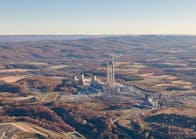Kioxia Group, a developer of flash memory and solid state drives, is installing large-scale solar power systems at its Kitakami and Yokkaichi plants in Japan to increase the usage of on-site renewable energy.
According to the company, the new solar power systems, installed on rooftops of the flash memory fabrication facilities, will have a total generating capacity of 7.5 MW. The Kioxia announcement does not mention the contractor on the solar installments.
The systems are expected to generate 7,600 MWh of electricity annually, reducing carbon dioxide emissions by 3,200 tons per year.
The solar power generation system at Kitakami plant (Fab1) started operating in January 2023, while the system at Yokkaichi plant (Fab6) is set to be operational in June 2023. The systems will be maintained and operated under a power purchase agreement model.
Construction on a Kitakami Fab2 (rendering above) began a year ago. The site utilizes AI-based manufacturing processes and is being completed this year.
Kioxia aims to source 100 percent of its energy from renewable sources, including solar power, by 2040. The company is a spinoff of Toshiba Corp.





